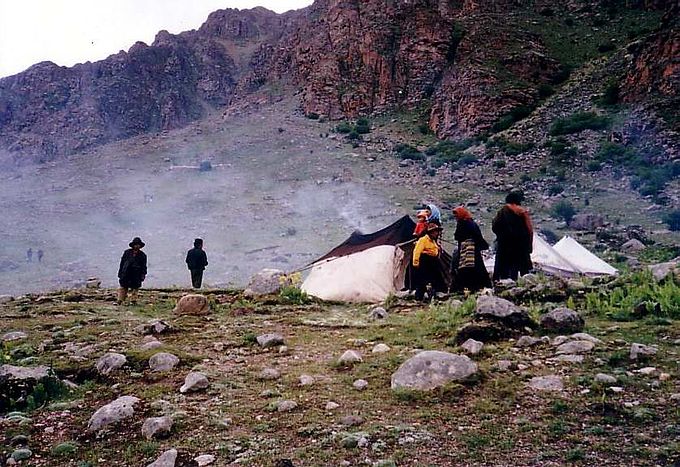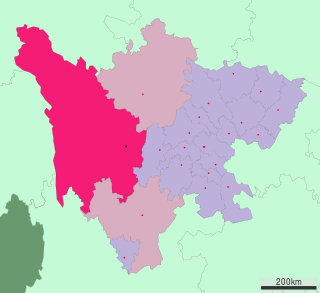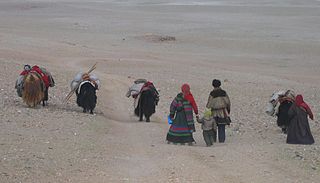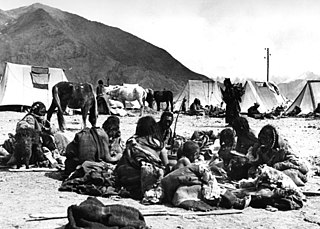This article includes a list of references, related reading or external links, but its sources remain unclear because it lacks inline citations .(December 2012) (Learn how and when to remove this template message) |

Nomadic tents are a vital source of housing for nomads living in mountainous regions of Central Asia. They are usually made from yak wool that has been hand spun into yarn and takes about a year to make a mid-sized tent.

A nomad is a member of a community of people without fixed habitation who regularly move to and from the same areas, including nomadic hunter-gatherers, pastoral nomads, and tinker or trader nomads. As of 1995, there were an estimated 30–40 million nomads in the world.

Central Asia stretches from the Caspian Sea in the west to China in the east and from Afghanistan in the south to Russia in the north. The region consists of the former Soviet republics of Kazakhstan, Kyrgyzstan, Tajikistan, Turkmenistan, and Uzbekistan. It is also colloquially referred to as "the stans" as the countries generally considered to be within the region all have names ending with the Persian suffix "-stan", meaning "land of".

Wool is the textile fiber obtained from sheep and other animals, including cashmere and mohair from goats, qiviut from muskoxen, from hide and fur clothing from bison, angora from rabbits, and other types of wool from camelids; additionally, the Highland and the Mangalica breeds of cattle and swine, respectively, possess wooly coats. Wool consists of protein together with a few percent lipids. In this regard it is chemically quite distinct from the more dominant textile, cotton, which is mainly cellulose.
Tibetan tents on the contrary are very thin in comparison where the sky can be seen through the hand spun yarn inside the tent. Nomad tents are held up using hand spun yak wool rope and 8 to 12 wooden poles. The top of the tent has a large opening that is used to let smoke out and to let the warm sunshine in. Prayer flags are in abundance and can be found flying from the tent roofs.

Tibet is a region covering much of the Tibetan Plateau in modern-day China. It is the traditional homeland of the Tibetan people as well as some other ethnic groups such as Monpa, Tamang, Qiang, Sherpa, and Lhoba peoples and is now also inhabited by considerable numbers of Han Chinese and Hui people. Tibet is the highest region on Earth, with an average elevation of 5,000 m (16,000 ft). The highest elevation in Tibet is Mount Everest, Earth's highest mountain, rising 8,848 m (29,029 ft) above sea level.

A Tibetan prayer flag is a colorful rectangular cloth, often found strung along trails and peaks high in the Himalayas. They are used to bless the surrounding countryside and for other purposes. Prayer flags are believed to have originated with Bon. In Bon, shamanistic Bonpo used primary-colored plain flags in Tibet. Traditional prayer flags include woodblock-printed text and images.
The insides of nomad tents are very basic as the nomads, often very poor, own few belongings. Inside there will be some sleeping mats and blankets, a stove, a table or two, a few extra clothes and a little food. Nearly all tents will have a picture of a local lama and often will have a picture of the 14th Dalai Lama. A thangka painting will also be found hanging inside.

Lama is a title for a teacher of the Dharma in Tibetan Buddhism. The name is similar to the Sanskrit term guru and in use it is similar, but not identical to the western monastic rank of abbot.

A thangka, variously spelt as thangka, tangka, thanka, or tanka, is a Tibetan Buddhist painting on cotton, silk appliqué, usually depicting a Buddhist deity, scene, or mandala. Thangkas are traditionally kept unframed and rolled up when not on display, mounted on a textile backing somewhat in the style of Chinese scroll paintings, with a further silk cover on the front. So treated, thangkas can last a long time, but because of their delicate nature, they have to be kept in dry places where moisture will not affect the quality of the silk. Most thangkas are relatively small, comparable in size to a Western half-length portrait, but some are extremely large, several metres in each dimension; these were designed to be displayed, typically for very brief periods on a monastery wall, as part of religious festivals. Most thangkas were intended for personal meditation or instruction of monastic students. They often have elaborate compositions including many very small figures. A central deity is often surrounded by other identified figures in a symmetrical composition. Narrative scenes are less common, but do appear.

Traditionally yaks are kept tied up outside of the tent using lines of rope with have 8 to 10 small loops around one of the yaks feet at night (or tied through the yak's nose) that are made secure by two wooden stakes driven into the ground. A few dogs will also be kept tied up outside the tent. Large piles of dried yak dung are stored close to the tent as an important source of fuel. It is even common to see Tibetan buddhist sculptures made in the yak dung.

A fuel is any material that can be made to react with other substances so that it releases energy as heat energy or to be used for work. The concept was originally applied solely to those materials capable of releasing chemical energy but has since also been applied to other sources of heat energy such as nuclear energy.

Hand woven yak wool tents are declining rapidly. Many nomads now only live in these tents in the summer months. They increasingly live in mudbrick homes the rest of the year. Others are now moving into towns to live in traditional style Tibetan homes or are being relocated into cities (such as Xining) where the government provides them with a modern style apartment.

A mudbrick or mud-brick is an air-dried brick, made of a mixture of loam, mud, sand and water mixed with a binding material such as rice husks or straw. Though mudbricks are known from 7000-6000 BCE, since 4000 BC, bricks have also been fired, to increase their strength and durability.

Xining is the capital of Qinghai province in western China, and the largest city on the Tibetan Plateau. It has 2,208,708 inhabitants at the 2010 census whom 1,198,304 live in the built up area made of 4 urban districts.
Although there the number of yak wool tents each year in Tibet and Inner China reduces every year, there are still several areas that have them in abundance. The northern regions of the Nagchu and Ngari prefectures in the Tibet Autonomous Region, Yushu prefecture in southern Qinghai and northern Ganzi prefecture in Sichuan province all have nomads still living in yak wool tents to this day.

The Tibet Autonomous Region (TAR) or Xizang Autonomous Region, called Tibet or Xizang for short, is a province-level autonomous region in southwest China. It was formally established in 1965 to replace the Tibet Area, an administrative division the People's Republic of China (PRC) took over from the Republic of China (ROC) about five years after the dismissal of the Kashag by the PRC following the 1959 Tibetan uprising, and about 13 years after Tibet's incorporation into the PRC in 1951.

Garzê Tibetan Autonomous Prefecture also known as Ganzi — is an autonomous prefecture of China occupying the western arm of Sichuan. It is sometimes spelled "Kardzé" and "Garzin" by non-government sources.

Sichuan is a province in southwest China occupying most of the Sichuan Basin and the easternmost part of the Tibetan Plateau between the Jinsha River on the west, the Daba Mountains in the north, and the Yungui Plateau to the south. Sichuan's capital city is Chengdu. The population of Sichuan stands at 81 million.














